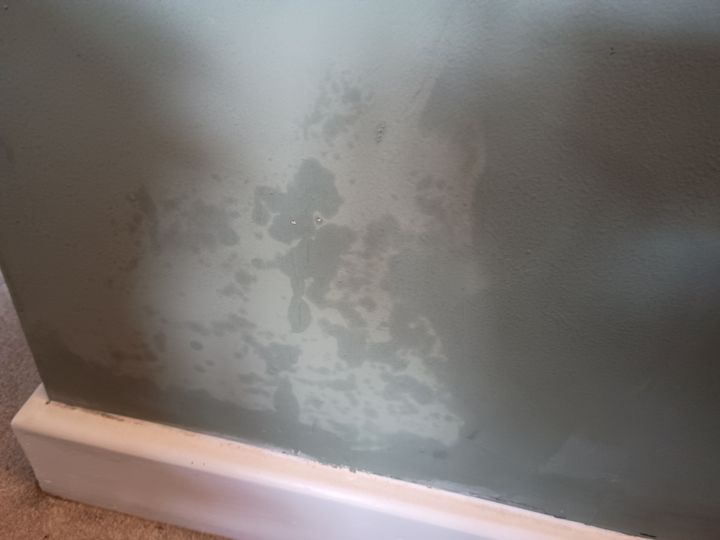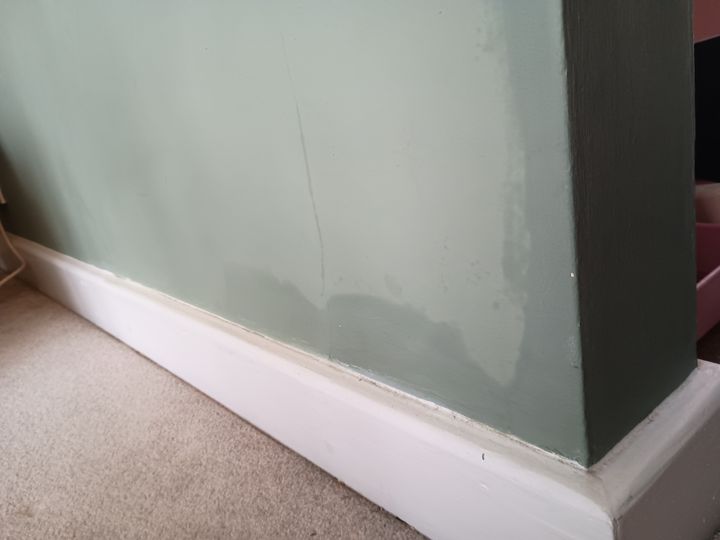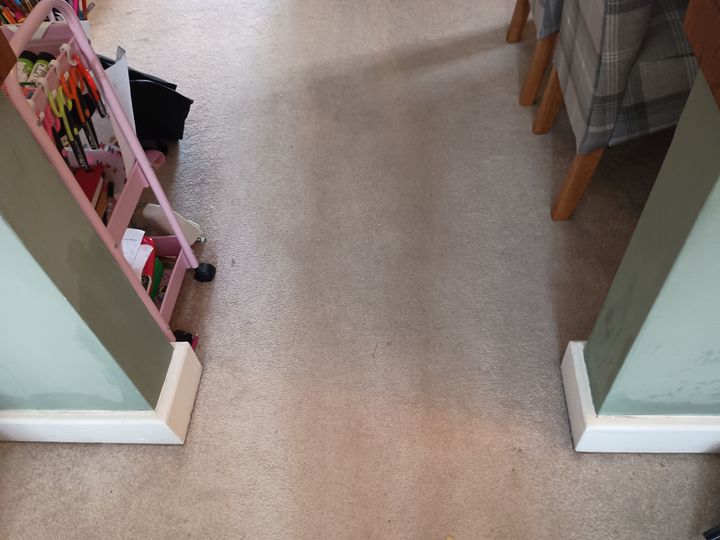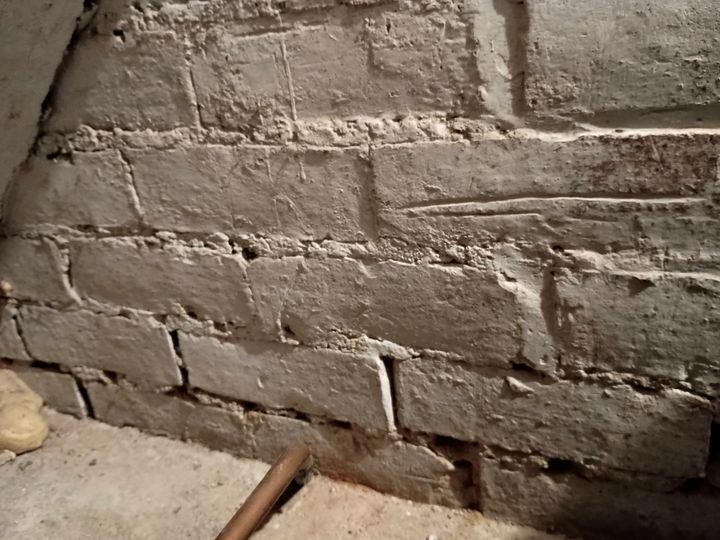What's causing this damp?
Discussion
We had our living room painted last year in a darker colour, and shortly after these damp patches appeared. I mention the darker colour as it was a light cream colour before and they may have been there all along!
They sometimes appear wetter, but don't seem to have spread or changed shape. There is a damp area in a corner, behind which is a cupboard under the stairs (I've included a picture of that). The wall in the cupboard under the stairs feels slightly damp but not excessively so.
The wall is broken up by kind of archway into the dining room - it is damp on either side but doesn't not extend very far the other side.
We've had a couple of people look at this and had different opinions. One suggested sanding the paint off the affected areas and using a heater to completely dry out the wall before repainting, while another suggested new damp proofing costing several thousand pounds.
There was damp proofing done quite a few years ago, which does have a 25 year guarantee, but the company that did this aren't interested as we weren't the owners of the house when it was done.
Appreciate any advice before I go spending a load of money!




They sometimes appear wetter, but don't seem to have spread or changed shape. There is a damp area in a corner, behind which is a cupboard under the stairs (I've included a picture of that). The wall in the cupboard under the stairs feels slightly damp but not excessively so.
The wall is broken up by kind of archway into the dining room - it is damp on either side but doesn't not extend very far the other side.
We've had a couple of people look at this and had different opinions. One suggested sanding the paint off the affected areas and using a heater to completely dry out the wall before repainting, while another suggested new damp proofing costing several thousand pounds.
There was damp proofing done quite a few years ago, which does have a 25 year guarantee, but the company that did this aren't interested as we weren't the owners of the house when it was done.
Appreciate any advice before I go spending a load of money!
Edited by mike80 on Tuesday 24th September 11:05
The damp proofing done a few years ago was most likely the pointless drill and inject approach. You can try anything you like to mask damp, but till you sort it properly it's always going to come back.
You need to have a proper look around the wall in question to find out where the waters coming from. The damp pattern will help as it will point at the issue. Looking at yours the suspicious bit is it's either side of the doorway that I assume was knocked through the wall? I'd be suspicious that the reason the understairs cupboard was damp was because of the room not the other way round. The damp seems to be coming up from the floor, so is a rare case of rising damp (it's usually not rising at all, most of the time it's penetrating from the other side). Assuming I'm right the next step would be to lift the carpet and find out what's going on with the floor, if it's a concrete floor I'd be suspecting the damp membrane has failed/not been installed when they knocked through. If it's floorboards though that becomes even more interesting. If it's a stud wall then I'd be even more flummoxed and would start suspecting possibly water ingress from above dropping down the cavity. But inspection is needed.
If you can do work yourself there is no real reason it needs to be expensive. We sorted a major damp issue out in our house just by identifying it and removing the source of the water. Within weeks the wall had dried out and the damps gone.
You need to have a proper look around the wall in question to find out where the waters coming from. The damp pattern will help as it will point at the issue. Looking at yours the suspicious bit is it's either side of the doorway that I assume was knocked through the wall? I'd be suspicious that the reason the understairs cupboard was damp was because of the room not the other way round. The damp seems to be coming up from the floor, so is a rare case of rising damp (it's usually not rising at all, most of the time it's penetrating from the other side). Assuming I'm right the next step would be to lift the carpet and find out what's going on with the floor, if it's a concrete floor I'd be suspecting the damp membrane has failed/not been installed when they knocked through. If it's floorboards though that becomes even more interesting. If it's a stud wall then I'd be even more flummoxed and would start suspecting possibly water ingress from above dropping down the cavity. But inspection is needed.
If you can do work yourself there is no real reason it needs to be expensive. We sorted a major damp issue out in our house just by identifying it and removing the source of the water. Within weeks the wall had dried out and the damps gone.
It really is impossible for anyone to diagnose the issue based upon photos on an internet forum but I will offer some 'gut' thoughts based upon over 40 years of surveying buildings and looking at 1,000s of damp issues in particular over that time
My immediate response would be incorrect plaster used (Carlite or browning) and contamination of the plaster by (hygroscopic) sulphates. This is based upon the (fairly random) pattern of the apparent dampness.
If you can borrow an electrical moisture meter a simple check would be to push the prongs into the skirtings and see what readings you get - over 18% wood moisture and you probably have an issue beyond the plaster. Typically plaster bridging the floor/wall junction causing wicking but that would not typically cause dampness to the height in your pics.
My immediate response would be incorrect plaster used (Carlite or browning) and contamination of the plaster by (hygroscopic) sulphates. This is based upon the (fairly random) pattern of the apparent dampness.
If you can borrow an electrical moisture meter a simple check would be to push the prongs into the skirtings and see what readings you get - over 18% wood moisture and you probably have an issue beyond the plaster. Typically plaster bridging the floor/wall junction causing wicking but that would not typically cause dampness to the height in your pics.
Don't want to hijack the thread but looks very similar to our internal walls (ie ones with no exterior face) damp patches that appear to be coming upwards and bubbling plaster that's crumbling in places. It was built in 1870's and don't think there is a DPC - my suspicion is also that wrong plaster has been used as it was 'refurbished' before we moved in!
Can anyone recommend a specialist in the Nottingham\Lincoln area specifically Newark?
Can anyone recommend a specialist in the Nottingham\Lincoln area specifically Newark?
towser44 said:
This is also similar to ours. Seeing the above comments re 'wrong plaster' what would/should be the correct plaster to use?
on a solid internal wall (that one looks like 9" bwk) either a renovating plaster or, more pragmatically, a 3:1 sand and cement render with waterproofer and setting coat tends to get the job done and will hold back most 'nasties'Lotobear said:
on a solid internal wall (that one looks like 9" bwk) either a renovating plaster or, more pragmatically, a 3:1 sand and cement render with waterproofer and setting coat tends to get the job done and will hold back most 'nasties'
Was expecting the answer to be Lime Plaster - is that what renovating plaster is?It looks like the moisture is greater heading towards the stairs?
Is it a semi detached or terraced house?
It does look like the usual wicking up of water from the ground that I've had in every single Victorian Cotswold house I've ever owned. It always amazes me how the central spine walls that are furthest from the outside can sometimes be the ones that wick up water. But I've had this sort of damp appear near adjoining walls before. A little surprised it looks so dry under the stairs?
Is it a semi detached or terraced house?
It does look like the usual wicking up of water from the ground that I've had in every single Victorian Cotswold house I've ever owned. It always amazes me how the central spine walls that are furthest from the outside can sometimes be the ones that wick up water. But I've had this sort of damp appear near adjoining walls before. A little surprised it looks so dry under the stairs?
JimM169 said:
Lotobear said:
on a solid internal wall (that one looks like 9" bwk) either a renovating plaster or, more pragmatically, a 3:1 sand and cement render with waterproofer and setting coat tends to get the job done and will hold back most 'nasties'
Was expecting the answer to be Lime Plaster - is that what renovating plaster is?Assuming you've got central heating but where are the rads placed downstairs?
I had rising damp on an internal wall turned out the copper pipes laid in the floors screed had been comprimised and had pinhole leaks causing something similar looking to what you have.
Had to dig out the pipes and replace, wrap and re-screed.
I had rising damp on an internal wall turned out the copper pipes laid in the floors screed had been comprimised and had pinhole leaks causing something similar looking to what you have.
Had to dig out the pipes and replace, wrap and re-screed.
The test driver said:
Assuming you've got central heating but where are the rads placed downstairs?
I had rising damp on an internal wall turned out the copper pipes laid in the floors screed had been comprimised and had pinhole leaks causing something similar looking to what you have.
Had to dig out the pipes and replace, wrap and re-screed.
Is that a pipe in the last picture?I had rising damp on an internal wall turned out the copper pipes laid in the floors screed had been comprimised and had pinhole leaks causing something similar looking to what you have.
Had to dig out the pipes and replace, wrap and re-screed.
DonkeyApple said:
It looks like the moisture is greater heading towards the stairs?
Is it a semi detached or terraced house?
It does look like the usual wicking up of water from the ground that I've had in every single Victorian Cotswold house I've ever owned. It always amazes me how the central spine walls that are furthest from the outside can sometimes be the ones that wick up water. But I've had this sort of damp appear near adjoining walls before. A little surprised it looks so dry under the stairs?
It's semi detached, which I didn't make clear from the floorplan. The stairs are on the outside of the building, so the adjoining house is on the opposite side.Is it a semi detached or terraced house?
It does look like the usual wicking up of water from the ground that I've had in every single Victorian Cotswold house I've ever owned. It always amazes me how the central spine walls that are furthest from the outside can sometimes be the ones that wick up water. But I've had this sort of damp appear near adjoining walls before. A little surprised it looks so dry under the stairs?
mike80 said:
It's semi detached, which I didn't make clear from the floorplan. The stairs are on the outside of the building, so the adjoining house is on the opposite side.
Anything against the outside wall at that point? Although one would expect to see moisture on those bricks in the picture if that's the inside under the stairs. Have you been able to link the damp to whether it's heating or rain connected if the patch ebbs and flows?
Looks like lack of DPC on the partition walls - not uncommon in a house of that age and 20 years ago the usual treatment was the pointless injected DPC. The warranty for the DPC should be transferable to a new owner, that's the main point of doing it, so have a word with the company
I assume its a suspended floor? Are the airbricks in place and clear?
You can get plaster that goes hygroscopic, but that would generally show as patches all over the wall.
You need a specialist to inspect it, but a builder no someone who will just try and sell you a snake oil DPC
I assume its a suspended floor? Are the airbricks in place and clear?
You can get plaster that goes hygroscopic, but that would generally show as patches all over the wall.
You need a specialist to inspect it, but a builder no someone who will just try and sell you a snake oil DPC
Gassing Station | Homes, Gardens and DIY | Top of Page | What's New | My Stuff



